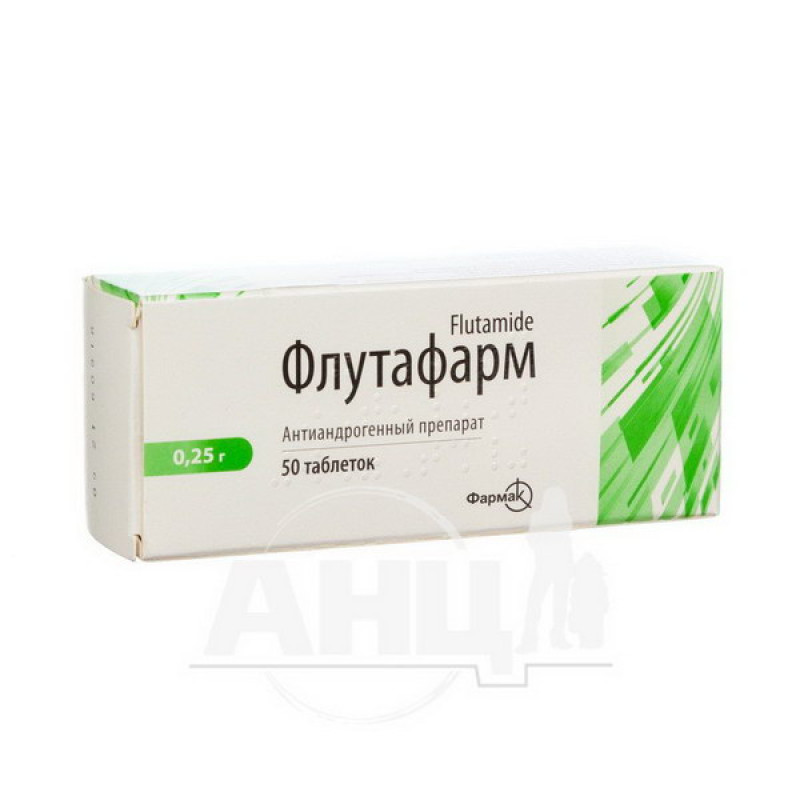Flutafarm tablets 0.25 g blister No. 50

Instructions Flutafarm tablets 0.25 g blister No. 50
Composition
active ingredient: flutamide;
1 tablet contains flutamide in terms of 100% substance – 250 mg (0.25 g);
Excipients: potato starch, lactose monohydrate, colloidal anhydrous silicon dioxide, calcium stearate.
Dosage form
Pills.
Main physicochemical properties: light yellow tablets, with a flat surface, a score and a bevel.
Pharmacotherapeutic group
Hormone antagonists and similar agents. Antiandrogenic agents. ATX code L02B B01.
Pharmacological properties
Pharmacodynamics.
Flutafarm® is an antiandrogenic drug with a non-steroidal structure. Flutamide and its metabolites do not have agonistic or antagonistic properties at glucocorticoid, estrogen, progestin, and mineralocorticoid receptors.
Flutamide blocks androgen receptors on target cells in the prostate, hypothalamus, and pituitary gland and inhibits the biological effects of endogenous androgens. However, flutamide does not inhibit the action of androgen-mediated secretion of gonadotropin-releasing hormone (GnRH) by the hypothalamus or affect the sensitivity of the pituitary gland to GnRH. This leads to an increase in the content of gonadotropic hormones (luteinizing and follicle-stimulating hormones), which in turn stimulates the overproduction of testosterone.
Flutamide and its metabolites inhibit the interaction of dihydrotestosterone with nuclear androgen receptors. Blockade of receptors can also occur at the level of the cell membrane and cytoplasm of the cell. The main metabolite is 2-hydroxyflutamide. Its affinity for androgen receptors is 25 times higher than that of flutamide, which allows us to consider it as the active form of flutamide.
The combination of flutamide with chemical or surgical castration results in the appearance of testicular and adrenal effects of androgens.
In women with hyperandrogenic conditions accompanied by infertility and disorders of the ovarian-menstrual cycle (e.g., polycystic ovary syndrome), Flutafarm® blocks the pathogenic effect of endogenous androgens on the ovaries and other reproductive organs, as well as on the hypothalamic-pituitary system. Due to this, the symptoms of hyperandrogenism (hirsutism) are reduced in patients, menstruation is restored, folliculogenesis and the menstrual cycle are improved, which probably leads to the restoration of fertile potential in some patients.
Pharmacokinetics.
After oral administration, Flutafarm® is well absorbed from the gastrointestinal tract. The maximum concentration in blood plasma is reached within 2 hours. Experiments using tritium-labeled flutamide indicate its rapid metabolism to the biologically active form - 2-hydroxyflutamide and to other metabolites. The half-life of the drug is 5-6 hours. There are approximately 10 metabolites of flutamide. More than 90% of flutamide and 2-hydroxyflutamide bind to blood plasma proteins. It is eliminated mainly by the kidneys. Approximately 4% of the dose taken is excreted in the feces.
Indication
Treatment of locally advanced or metastatic prostate cancer as monotherapy (with or without orchiectomy) or in combination with luteinizing hormone-releasing hormone (LH-RH) agonists in previously untreated patients or in patients who are unresponsive to, or who are resistant to, or intolerant of hormonal therapy, in order to achieve maximal androgen blockade.
In combination therapy - as one of the means for the treatment of locally limited prostate cancer B2 - C2 (T2b - T4), to reduce tumor volume, increase tumor control, and increase the period between exacerbations of the disease.
Treatment of women with functional hyperandrogenism accompanied by ovarian-menstrual cycle disorders, hirsutism, polycystic ovary syndrome, and infertility.
Contraindication
Hypersensitivity to flutamide or to other components of the drug. For women, additional contraindications to taking Flutafarm® are organic hyperandrogenism (ovarian and adrenal cortex tumors). Severe hepatic insufficiency (baseline liver enzyme levels should be assessed before starting treatment).
Childhood.
Interaction with other medicinal products and other types of interactions
No interaction of flutamide with leuprolide has been observed. When flutamide is used concomitantly with LHRH agonists, the potential for adverse effects of both drugs should be considered.
In patients receiving long-term warfarin therapy, an increase in prothrombin time has been noted after the use of flutamide. Therefore, it is necessary to select the optimal dose of the anticoagulant.
With the combined use of flutamide and theophylline, an increase in theophylline concentration in blood plasma is possible.
The concomitant use of flutamide and potentially hepatotoxic drugs should be avoided.
When used simultaneously, there is a possibility of interaction with paracetamol and opioid analgesics.
Flutamide may slow the metabolism of corticosteroids.
Since androgen deprivation treatment may prolong the QT interval, the concomitant use of Flutafarm® with drugs that prolong the QT interval or with drugs that can induce ventricular flutter/fibrillation, such as class IA (e.g. quinidine, disopyramide) or class III (e.g. amiodarone, sotalol, dofetilide, ibutilide) antiarrhythmic drugs, methadone, moxifloxacin, neuroleptics, etc., should be carefully evaluated.
Application features
As part of combination therapy with LHRH agonists, Flutafarm® therapy should be initiated at least 3 days before the administration of LHRH agonists, which contributes to less pronounced inflammatory hyperemia than with parallel initiation of therapy.
Treatment should be carried out under the supervision of a doctor.
In case of liver function disorders, the use of flutamide as long-term therapy is possible only after a careful assessment of the potential benefits and risks.
Liver function tests should be performed before starting treatment. Treatment with the drug should not be initiated in patients with serum transaminase levels 2-3 times the upper limit of normal.
Liver function tests should be performed throughout the treatment period, especially in patients who have not undergone orchiectomy, as adverse reactions such as cholestatic jaundice, hepatic necrosis, altered transaminase levels, and hepatic encephalopathy have been reported. Appropriate laboratory testing should be performed monthly for the first 4 months of treatment and periodically thereafter and at the first symptoms/signs of liver dysfunction (itching, dark urine, persistent loss of appetite, jaundice, moderate right upper quadrant tenderness, or general weakness).
In case of laboratory confirmation of liver function abnormalities or jaundice, in the absence of biopsy-confirmed liver metastases, treatment with the drug should be discontinued if the patient continues to develop jaundice or if serum transaminase levels exceed 2-3 times the upper limit of normal, even in the absence of clinical symptoms. Liver function abnormalities are usually reversible after discontinuation of Flutamide® treatment. However, there are reports of fatalities due to severe liver damage caused by flutamide.
Androgen deprivation therapy may prolong the QT interval.
The physician should assess the risk-benefit ratio, including the potential for ventricular flutter/fibrillation, before initiating treatment with Flutafarm® in patients with a history of or risk factors for QT prolongation and in patients receiving concomitant medications that may prolong the QT interval.
Patients with impaired renal function should be closely monitored during flutamide therapy.
In case of cyanosis, the patient should be checked for methemoglobinemia, which can develop with overdose.
In patients who have not undergone orchiectomy, during long-term treatment with the drug, it is necessary to periodically determine the number of spermatozoa. Since flutamide treatment increases the levels of testosterone and estradiol in the blood plasma, fluid retention in the body tissues is possible, so the drug should be prescribed with caution to patients with heart disease. In addition, an increase in estradiol levels may increase the risk of thromboembolism.
With prolonged use of Flutafarm®, oligospermia may occur. In this case, it is advisable to perform a quantitative sperm analysis.
Flutafarm® contains lactose, therefore patients with rare hereditary forms of galactose intolerance, lactase deficiency or glucose-galactose malabsorption syndrome should not use the drug.
When combined therapy with Flutafarm® and an LHRH agonist, the possible side effects of each drug should be taken into account.
Patients should be informed that flutamide and drugs intended for medical castration must be used in combination and should not be discontinued or doses changed without prior consultation with a physician.
Before using Flutafarm®, women must exclude hyperandrogenism of organic origin (ovarian and adrenal cortex tumors).
You should not drink alcohol during treatment.
Use during pregnancy or breastfeeding
When using the drug, women should pay special attention to preventing pregnancy using non-hormonal, in particular barrier contraceptives. In the event of a positive pregnancy test, the drug should be discontinued immediately. Sexual intercourse with the aim of achieving a desired pregnancy can be resumed no earlier than 48 hours after the last dose of Flutafarm®.
Ability to influence reaction speed when driving vehicles or other mechanisms
Usually the drug does not affect the reaction speed when driving or using other mechanisms, but in rare cases fatigue, dizziness, partial loss of consciousness are possible. In such cases, it is necessary to refrain from driving or using other mechanisms.
Method of administration and doses
Flutafarm® is prescribed to patients with prostate cancer as a monotherapy (after or without orchiectomy) or in combination with LHRH agonists, 1 tablet (250 mg) 3 times a day every 8 hours. The daily dose is 750 mg.
In the case of combination therapy with LHRH agonists, both drugs can be prescribed simultaneously or Flutafarm® can be started 3 days before the start of LHRH agonist therapy.
In the case of radiotherapy, Flutafarm® should be prescribed 8 weeks before its start and the drug should be continued throughout the entire course of radiotherapy.
Women with hyperandrogenic conditions should be prescribed Flutafarm® orally, 1/2 tablet (125 mg) 3 times a day for 3-6 months. Take during or after meals. The use of non-hormonal contraceptives, including barrier ones, is mandatory.
Children. The drug should not be used to treat children.
Overdose
In animal experiments, flutamide caused hypoactivity, piloerection, slowed respiratory rate, caused ataxia and/or lacrimation, anorexia, sedation, vomiting, and methemoglobinemia.
Clinical data indicate that flutamide taken at a daily dose of up to 1500 mg for 36 weeks does not cause serious side effects. Gynecomastia, breast engorgement, and transient changes in liver transaminase levels sometimes occur. A single dose of flutamide (up to 5 g) does not cause symptoms of overdose and is not life-threatening.
Symptoms of overdose that would threaten a person's life are unknown.
Given the high degree of binding of flutamide to plasma proteins, it cannot be removed by dialysis. As in the treatment of overdose of any drug, the possibility of simultaneous administration of several drugs by the patient should be taken into account. General measures to monitor and maintain vital parameters of the body are indicated. Gastric lavage may be required.
Side effects
In monotherapy, the most common adverse reactions during treatment with Flutafarm® are gynecomastia and/or breast tenderness, sometimes accompanied by galactorrhea. These reactions disappear after discontinuation of treatment or dose reduction.
Flutamide causes a temporary increase in hepatic transaminases due to hepatitis.
In combination therapy, the most common side effects with flutamide and an LHRH agonist may be hot flashes, decreased libido, impotence, diarrhea, nausea, and vomiting. These side effects, with the exception of diarrhea, occur with LHRH agonist monotherapy with a relatively similar frequency.
The incidence of gynecomastia with combination therapy with flutamide and an LHRH agonist is significantly lower compared to flutamide monotherapy and does not significantly differ from the incidence with placebo.
In monotherapy
Infections and infestations
Rare: herpes zoster.
From the side of the hematopoietic and lymphatic system
Rare: lymphedema.
Anemia, leukopenia, thrombocytopenia, methemoglobinemia, ecchymoses.
Nutritional and metabolic disorders
Common: increased appetite.
Rare: anorexia.
From the psychological side.
Common: insomnia.
Rare: depression, anxiety.
From the nervous system.
Rare: dizziness, headache.
Drowsiness.
From the immune system.
Rare: lupus-like syndrome.
From the organs of vision.
Rare: blurred vision.
From the cardiovascular system.
Rare: hot flashes.
Frequency unknown: QT prolongation.
Cardiovascular disorders.
On the part of the respiratory system.
Rare: dyspnea.
Very rare: cough.
From the gastrointestinal tract.
Common: diarrhea, nausea, vomiting, increased appetite.
Rare: nonspecific complaints about the functioning of the gastrointestinal tract, heartburn, constipation.
Gastrointestinal dysfunction, stomach pain, indigestion, ulcerative pain, stomatitis.
From the liver and biliary tract.
Common: hepatitis.
Jaundice, increased liver function tests.
Liver disorders usually resolve after discontinuation of flutamide; severe toxic hepatitis, liver necrosis, and hepatic encephalopathy (these adverse reactions are usually reversible and resolve upon discontinuation of therapy). Isolated fatalities associated with drug-induced liver injury have been reported.
From the kidneys and urinary tract.
Increased levels of urea and creatinine in the blood (the severity of this side effect usually does not require dose reduction or discontinuation of the drug), change in urine color to green.
On the skin and subcutaneous tissue.
Rare: itching, subcutaneous hemorrhages.
Very rare: photosensitivity.
Rash, alopecia, reversible changes in hair structure may develop at the beginning of flutamide therapy.
From the reproductive system and mammary glands.
Very common: gynecomastia and/or breast pain, galactorrhea.
Rare: decreased libido, decreased sperm production.
Changes in the mammary glands, at the beginning of flutamide monotherapy, an increase in plasma testosterone levels, which is reversible, and breast pain are possible.
Benign and malignant tumors.
Very rare: breast tumors in men.
General violations.
Common: increased fatigue.
Rare: edema, weakness, anxiety, thirst, chest pain.
Fever.
Research.
With combination therapy
From the side of the hematopoietic and lymphatic system
Rare: anemia, leukopenia, thrombocytopenia.
Very rare: hemolytic anemia, macrocytic anemia, methemoglobinemia, sulfhemoglobinemia.
Metabolic disorders.
Rare: anorexia.
Very rare: hyperglycemia, exacerbation of diabetes mellitus.
From the psychological side.
Rare: depression, anxiety.
Restlessness, neurosis, drowsiness, insomnia, irritability.
From the nervous system.
Rare: numbness, confusion, nervousness.
Signs of neuromuscular diseases.
From the cardiovascular system.
Very common: hot flushes.
Rare: arterial hypertension.
Frequency unknown: thromboembolism, QT prolongation.
Cases of thrombophlebitis, pulmonary embolism, and myocardial infarction have been reported.
On the part of the respiratory system, thoracic cavity and mediastinum.
Very rare: pulmonary symptoms (e.g. dyspnoea), interstitial lung disease.
Dyspnea.
From the gastrointestinal tract.
Very common: diarrhea, nausea, vomiting.
Rare: non-specific complaints about the functioning of the gastrointestinal tract.
From the liver and biliary tract.
Uncommon: hepatitis.
Rare: liver dysfunction, jaundice.
Very rare: cholestatic jaundice, hepatic encephalopathy, hepatic necrosis, fatal outcomes due to severe liver damage associated with the use of flutamide.
Increased levels of liver enzymes, bilirubin, and residual nitrogen.
On the skin and subcutaneous tissue.
Rare: rash.
Very rare: photosensitivity, erythema, ulcers, epidermal necrolysis.
Itching, blistering.
From the kidneys and urinary tract.
Rare: genitourinary symptoms
Very rare: change in urine color to amber and yellow-green.
Dysuria, change in urinary frequency.
From the reproductive system and mammary glands.
Very common: decreased libido, impotence.
Uncommon: gynecomastia.
Musculoskeletal and connective tissue disorders.
Rare: neuromuscular symptoms (including muscle weakness, paresthesias, seizures).
Arthralgia, myalgia.
Research.
Rare: increased urea and increased serum creatinine concentration.
General violations.
Rare: edema.
Feeling of heat, pain in the abdominal area.
Expiration date
3 years.
Do not use the drug after the expiration date indicated on the package.
Storage conditions
In a place protected from light at a temperature not exceeding 25 ºС.
Keep out of reach of children.
Packaging
10 tablets in a blister, 5 blisters in a pack.
Vacation category
According to the recipe.
Producer
JSC "Farmak".
Address
Ukraine, 04080, Kyiv, Kyrylivska St., 74.
There are no reviews for this product.
There are no reviews for this product, be the first to leave your review.
No questions about this product, be the first and ask your question.











